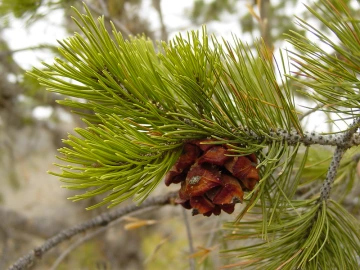
CARLOS VELAZCO Flickr.com
Botanical Family: Pinaceae
Scientific Name: Pinus cembroides
Common Names: Pinyon pine, Mexican pinyon, stone pine, nut pine, Mexican nut pine, pino piñonero, piñón de Orizaba
Botanical Description (flora/treatment):
Pinus cembroides is an evergreen conifer that develops a pyramidal habit up to 50 feet tall and 20 feet wide (1, 2). The spread is strongly tapering, with a rounded canopy, dense lower growth, and ascending branches (2). The bark is reddish to dark-brown, with scaly, broad ridges and irregular furrows (3). Needles are commonly borne in groups of 3 per fascicle – occasionally, 2 or 4 – and are stiff, bluish-gray, and multi-sided (1, 2). The pollen cones are yellow and ellipsoid shaped, while the seed cones are pale yellow to pale reddish-brown. Seed cones mature 2 years after pollination, and will quickly shed the wingless, brown seeds and fall from the tree (1).
Ecological Significance:
Mexican pinyon seeds are a valuable food source to native wildlife, and are commonly consumed by packrats (4). Merriam’s turkey, thick-billed parrot, black bear, porcupine, squirrels, chipmunks, and collared peccary also consume the seeds, among numerous other species. The growth is browsed by cattle, goats, and mule deer, but overgrazing can damage the survival of new strands. Finally, Mexican pinyon forests provide cover for white-tailed deer, pronghorn, rock squirrels, mountain cottontail rabbits, mice, ringtails, and hog-nosed skunks, in addition to foraging opportunities for insectivores (5).
Ethnobotanical Value: (Indigenous, cultural, medicinal, or other use)
The pinyon nuts of P. cembroides are the main commercial pine nut of Mexico, and are widely harvested by commercial pickers and Indigenous people in the southwest (4, 5). The oily seed kernel is eaten raw, roasted, and ground into nut-butter or a flour to produce bread. Although the inner bark can be dried and ground into a powder to thicken soups or cereals, it is only consumed in dire need (6). The resin is used to waterproof and cement pots, baskets, and jewelry, and produces a vanillin flavoring (5, 6). Culturally, the species has been valued as an ornamental, bonsai, and is commonly cultivated for Christmas trees (2, 5, 6). While the wood has been harvested for fuel, fenceposts, and small construction timber, it is rarely used for lumber. Medicinally, the gum that is exuded from damaged bark is used to treat sore throats, while the resin can be used to produce an antiseptic, diuretic, rubefacient, and anthelmintic turpentine. The turpentine is used both internally and externally to treat rheumatic afflictions, respiratory infections, skin complaints, and for kidney and bladder complications (6). Finally, P. cembroides has also been used as a highway median, and in reclamation projects (2).

